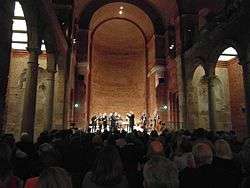Taschenphilharmonie
Taschenphilharmonie (Pocket philharmonic) is a German orchestra, founded in 2005 by Peter Stangel. The chamber ensemble plays symphonic works in three series, with most concerts held at the Allerheiligen-Hofkirche of the Munich Residenz. In addition to concerts which juxtapose classical and contemporary music, they address children in a second series and listeners interested in the making of a composition in a third. The ensemble has styled its name first as die taschenphilharmonie.
| Taschenphilharmonie | |
|---|---|
| Chamber ensemble | |
 The ensemble at the Allerheiligen-Hofkirche with composer Graham Waterhouse (left) and conductor Peter Stangel on 20 November 2016 | |
| Founded | 1995 |
| Location | Munich, Germany |
| Principal conductor | Peter Stangel |
| Website | www |
History and program
The ensemble continues a tradition that Arnold Schönberg began in Vienna in 1918 in Wien: the Verein für musikalische Privataufführungen played chamber versions of orchestral works.[1] The format has been compared to the pocket book.[2] The ensemble has been called "das kleinste Sinfonieorchester der Welt" (the world's smallest orchestra).[3]
One concert series of the Taschenphilharmonie is called Abenteuer für die Ohren (Adventure for the ears), combining works by two or three composers, usually contrasting classical and contemporary.[4] A concert on 20 November contrasted Beethoven's 2nd symphony with Jan Václav Voříšek's Symphony in D and a work by Graham Waterhouse,[5] whose Concerto da camera they had premiered in 1911.[6] Another premiere was =11= by Alexander Strauch, played at the Black Box of the Gasteig.[7] The ensemble performed works such as Wilhelm Killmayer's Sinfonia 2 on the occasion of the composer's 80th birthday in 2007, Wilfried Hiller's Hamelin in 2008, Stravinsky's Concerto in E-flat "Dumbarton Oaks" in 2009, Kurt Weill's Second Symphony in 2010, and Schoenberg's A Survivor from Warsaw in 2015.[8]
A second series addresses children age four to nine. Große Musik für kleine Hörer (Great music for small listeners) introduces classical music to children focusing on a single composer, with the presentation of the music being embedded in a story with Stangel as the narrator.[9][10] Concerts are also played at kindergartens and schools.[2] The 2016 season began with a concert on Humperdinck's Hänsel und Gretel.[11] The concerts reach about thousand children per year in live concerts.[9] The series was awarded the Leopold in 2011,[9] Sommernachtstraum was in the "Bestenliste" (List of the best) of the Preis der deutschen Schallplattenkritik in 2013[12]
A third series is called Hörakademie (Listening academy), offering background information for one work with sound examples before intermission, the complete work afterwards.[4] In 2010, the topic were Mahler's Rückert-Lieder, performed with the baritone Wolfgang Wirsching at the Kleiner Konzertsaal of the Gasteig.[3] On 3 March 2016 they analysed and played Mendelssohn's Italian Symphony,[13] on 27 November 2016 Beethoven's 2nd symphony is explored.[14] The series is organized in collaboration with the Munich Volkshochschule[13] and the Hochschule für Musik und Theater München.[3] It was transferred to the Künstlerhaus in the Lenbachhaus beginning in 2016.[14][15]
Publications
- Große Musik für kleine Hörer, an edition of 13 CDs in collaboration with Die Zeit and SONY classical,[9] including
- Ein Sommernachtstraum, reading with music. ISBN 978-3-8445-1002-7
- Die vier Jahreszeiten, reading with music. ISBN 978-3-8445-1001-0
- Peer Gynt, reading with music. ISBN 978-3-8445-1135-2
- Hänsel und Gretel, reading with music. ISBN 978-3-8445-1134-5
- Eine musikalische Schlittenfahrt. Vom Englein, das nicht singen konnte, reading with music. ISBN 978-3-86717-987-4.
- Mahler: Lieder eines fahrenden Gesellen (Susan Maclean, mezzo-soprano) and Symphony No. 4 (Hélène Lindqvist, soprano)
- Mahler: Symphony No. 7, version for chamber ensemble, world premiere recording
- Peter Stangel: Oboe und Co oder Was macht das Horn im Wald: Die Instrumente stellen sich vor. ISBN 978-3938822326
Awards
- 2011 Leopold for Große Musik für kleine Hörer[9]
- 2013 Preis der deutschen Schallplattenkritik for Sommernachtstraum[12]
References
- 10 Jahre taschenphilharmonie / Sinfonieorchester im Taschenformat (in German). WDR. 1 February 2016. Retrieved 18 November 2016.
- "Ohne Konservierungsstoffe". Merkur (in German). 2009. Retrieved 23 November 2016.
- "Die Hörakademie: Gustav Mahler – Rückert-Lieder" (in German). Gasteig. 2010. Retrieved 23 November 2016.
- Prechtel, Adrian (22 January 2016). "AZ-Interview mit Peter Stangel / Taschenphilharmonie: Wie tickt Beethoven?". Abendzeitung (in German). Retrieved 18 November 2016.
- "Beethoven, Waterhouse & Voříšek" (PDF). Jahresprogramm (in German). Taschenphilharmonie. 2016. p. 9. Retrieved 22 November 2016.
- "Abenteuer für die Ohren" (PDF) (in German). Taschenphilharmonie. 2011. Retrieved 22 November 2016.
- Strauch, Alexander. "Bio Alexander Strauch". Alexander Strauch. Retrieved 23 November 2016.
- "Concerts by Taschenphilharmonie". Schott. Retrieved 23 November 2016.
- "Leopold 2011/2012 / Große Klassik für kleine Hörer / Die Zeit-Edition" (in German). Leopold. 2011. Retrieved 23 November 2016.
- Stangel, Peter (2013). Wie man Kindern Lust auf Klassik macht. Große Musik für kleine Hörer. Sport für die Grundschule (in German). Oldenbourg Schulbuchverlag.
- "Engelbert Humperdinck / "Hänsel und Gretel"" (PDF). Jahresprogramm (in German). Taschenphilharmonie. 2016. p. 15. Retrieved 22 November 2016.
- "Der Preis der deutschen Schallplattenkritik ist in Deutschland die einzige unabhängige Auszeichnung für Tonträger". Eßlinger Zeitung (in German). 7 September 2013. Retrieved 22 November 2016.
- MusikPodium – Musikverständnis (PDF) (in German). Münchener Volkshochschule. 2016. pp. 1, 5. Retrieved 23 November 2016.
- "Ludwig van Beethoven: Sinfonie Nr. 2 D-Dur, op.36" (in German). Künstlerhaus. 2016. Retrieved 22 November 2016.
- "Näher dran / Das kleinste Sinfonieorchester der Welt" (PDF). Jahresprogramm (in German). Taschenphilharmonie. 2016. p. 5. Retrieved 5 December 2016.
External links
- Official website
- Die Taschenphilharmonie kulturkurier.de
- Die Taschenphilharmonie (in German) Theatergemeinde München
- Die taschenphilharmonie – Freunde der Taschenphilharmonie e.V. (in German) musenkuss-muenchen.de
- Bunt und lehrreich! / Münchens musikalische Kultur- und Veranstaltungsszene für Vorschulkinder (in German) familie-muenchen.de